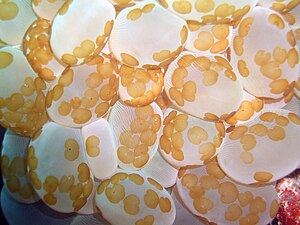Acoelomorpha
| Acoelomorpha | ||||||||||
|---|---|---|---|---|---|---|---|---|---|---|

Waminoa sp. on a bubble coral |
||||||||||
| Systematics | ||||||||||
|
||||||||||
| Scientific name | ||||||||||
| Acoelomorpha | ||||||||||
| Ehlers , 1985 |
The Acoelomorpha ("A" = not, no; "coela" = Coelom, intestine) are a taxon of very small worm-like animals that were originally part of the class of vortex worms (Turbellaria) and thus to the flatworms (Plathelminthes). In 2004 they were raised to the rank of a tribe by Baguña & Riutort, and in 2011 Philippe and colleagues assigned them to the Xenacoelomorpha as a sub-tribe.
features
They are very small animals that do not have a digestive tract. Outwardly they resemble flatworms, live in the sea, between the particles of sediment, planktonic or on the surface of algae or corals. Like flatworms, they lack coelom .
Investigations of the ribosomal DNA as well as the number and type of Hox genes came to the conclusion that most of the sub-taxa of flatworms within the primordial mouths (protostomia) belong to the Lophotrochozoa , while the acoelomorpha belong to the new mouths (deuterostomia). More recent studies suggest that a more basic position than the sister group of the rest of the Bilateria appears more likely.
Way of life
Some acoelomorpha e.g. B. the genus Waminoa live in symbiosis with zooxanthellae and feed on their photosynthesis products , among other things . Convoluta lives in symbiosis with the unicellular green alga Tetraselmis convolutae .
Systematics
The Acoelomorpha belong to two classes, the Acoela and the Nemertodermatida :
- Acoelomorpha Ehlers, 1985 (2 classes)
- Class Nemertodermatida Karling, 1940 (2 families)
- Family Ascopariidae Sterrer, 1998 (2 genera, 4 species)
- Family Nemertodermatidae Steinböck, 1930 (4 genera, 5 species)
- Class Acoela Uljanin, 1870 (16 families)
- Family Diopisthoporidae Westblad, 1940 (1 genus, 5 species)
- Klade Bitesticulata Jondelius, Wallberg, Hooge & Raikova, 2011
- Family Paratomellidae Dörjes, 1966 (2 genera, 3 species)
- Klade Bursalia Jondelius, Wallberg, Hooge & Raikova, 2011
- Klade Prosopharyngida Jondelius, Wallberg, Hooge & Raikova, 2011
- Family Hallangiidae Westblad, 1946 (2 genera, 2 species)
- Family Hofsteniidae Bock, 1923 (3 genera, 6 species)
- Family Solenofilomorphidae Dörjes, 1968 (5 genera, 10 species)
- Clade Crucimusculata Jondelius, Wallberg, Hooge & Raikova, 2011
- Family Dakuidae Hooge, 2003 (3 genera, 21 species)
- Family Isodiametridae Hooge & Tyler, 2005 (22 genera, 90 species)
- Family Otocelididae Westblad, 1948 (5 genera, 9 species)
- Family Proporidae Graff, 1882 (14 genera, 62 species)
- Klade Aberrantospermata Jondelius, Wallberg, Hooge & Raikova, 2011
- Family Convolutidae Graff, 1905 (24 genera, 114 species)
- Family Mecynostomidae Dörjes, 1968 (11 genera, 32 species)
- Klade Prosopharyngida Jondelius, Wallberg, Hooge & Raikova, 2011
- Family incertae sedis Actinoposthiidae Hooge, 2001 (10 genera, 22 species)
- Family incertae sedis Antigonariidae Dörjes, 1968 (1 genus, 1 species)
- Family incertae sedis Antroposthiidae Faubel, 1976 (3 genera, 3 species)
- Family incertae sedis Nadinidae Dörjes, 1968 (1 genus, 3 species)
- Family incertae sedis Tauridae Kostenko, 1989 (1 genus, 1 species)
- Class Nemertodermatida Karling, 1940 (2 families)
literature
- Jaume Baguñà, Marta Riutort: Molecular phylogeny of the Platyhelminthes. In: Canadian Journal of Zoology. Vol. 82, No. 2, 2004, pp. 168-193, doi : 10.1139 / z03-214 .
- Richard Dawkins : Stories from the Origin of Life: A Time Travel in Darwin's Footsteps. Ullstein, Berlin 2008, ISBN 3-550-08748-9 , pp. 645-650.
- Wilfried Probst: Early evolution and symbiosis. . Europa-Universität Flensburg, Institute for Biology and Science Education and its Didactics, accessed on April 19, 2019, § Plant animals and kleptoplasts .
Individual evidence
- ↑ a b Hervé Philippe, Henner Brinkmann, Richard R. Copley, Leonid L. Moroz, Hiroaki Nakano, Albert J. Poustka, Andreas Wallberg, Kevin J. Peterson, Maximilian J. Telford: Acoelomorph flatworms are deuterostomes related to Xenoturbella. In: Nature . Vol. 470, No. 7333, 2011, pp. 255-258, doi : 10.1038 / nature09676 .
- ↑ Seth Tyler, Stephen Schilling: Phylum Xenacoelomorpha. (PDF; 33 kB). In: Zootaxa . Vol. 3148, 2011, pp. 24-25, doi : 10.11646 / zootaxa.3148.1.6 .
